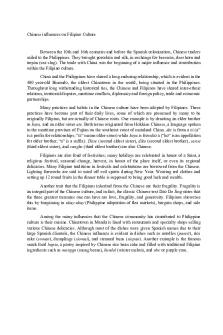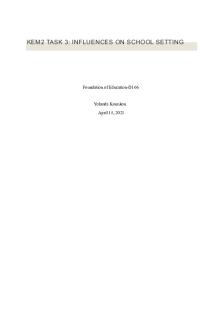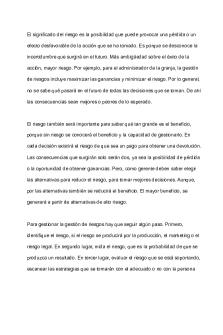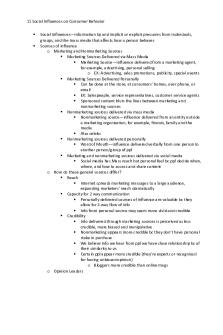Influences on Operations Essay PDF

| Title | Influences on Operations Essay |
|---|---|
| Author | Joshua Ho |
| Course | Business Studies |
| Institution | Higher School Certificate (New South Wales) |
| Pages | 6 |
| File Size | 127.1 KB |
| File Type | |
| Total Downloads | 100 |
| Total Views | 142 |
Summary
Operations Essay for business studies 2020 HSC...
Description
Evaluate the response of operations management to its influences.
There are many interior and exterior influences upon the business operations that largely affect how the management is performed. To respond successfully and turning threats and opportunities into strengths, can result in the increase of productivity, efficiency and profit maximisation; the goals of strategic operations management. These applied strategies can be seen within the context of modern day contemporary businesses such as Mc Donalds which not employs over 60,000 employees, but spans over one hundred countries. Four influences that may be of increasingly relevant issues today include technology, quality expectations, environmental sustainability and corporate social responsibility. It can be said that Mc Donald’s varied approaches towards these influence has largely been successful contributing to its corporate success and profit maximisation.
QUALITY EXPECTATIONS Quality expectations is referred to as the exceeding or meeting of a customer’s expectations. It is expected that businesses will provide high quality for money products in order to satisfy the individual’s preferences. There are three main defining factors of quality expectation including fit for purpose, durability, and quality of inputs. Similarly, Mc Donalds has successfully addressed and exceeded the expectations of these three factors. The relative reliability of a product is known as durability, and through this, the implementation of a sophisticated supply chain has allowed Mc Donalds to readily meet with demands and ensure available stock at any given moment. To satisfy their ‘fit for purpose” Mc Donalds have aligned their operations process to comply with the Food and health safety act in which all their products must be systematically checked for food safety. Furthermore, Mc Donalds has abolished the use of preservatives in chicken nuggets and in some breakfast menu’s to increase their quality of inputs, and hence, proving to become a healthier and safer food industry market share holder. Thus, through the influence of quality expectations, Mc Donalds as a major competitor in the food industry, has successfully responded to the influence of quality within their management.
GLOBALISATION Another large influence that affects the way in which business operations management is conducted, is globalisation. Globalisation is the increased integration between economies and countries which allows a greater transfer of capital allowing greater investment, business production and trade. With the current modern age, global businesses have been becoming prominent, and with the increased globalisation, there are many new flow on effects that may influence businesses. Globalisation allows businesses to source materials and labour from other locations, hence providing cheaper inputs for the transformation process. However, as businesses transition globally, this has opened up larger customer bases and hence, to satisfy the growing demand and diverse preferences, businesses such as Mc Donalds has adapted readily through the Halal burger and Mc Kebab. Mc Donalds has also invested billions of dollars into their vendors within Europe, in order to satisfy the customer preferences in the European region. Hence, Mc Donalds to a great extent, has also utilised the benefits and disadvantages of globalisation to an extent where they are able to produce profit and larger customer bases.
TECHNOLOGY Robotics refers to programmed machines that are designed to perform repetitive tasks, replacing production line employees. Robotics allow businesses to perform hazardous tasks with little risk and increased productivity for 24 hours a day along with the advantage of minimal errors hence applying a cost reduction strategy. Apple’s supplier Foxconn has installed 40,000 robots for handling manufacturing at a number of its factories in China. These robots have been replacing humans as they are able to produce and manufacture large quantities of Apple products in short periods of times. The
adoption of robotics have significantly decreased the cost of operations as wages are cut due to redundancy and the increased efficiency. The increase in communications technologies and internet have allowed firms to easily outsource and source their materials from other countries. Not only has internet allowed the sourcing of materials from foreign areas, however, the increased integration of mobile ordering into modern firms have allowed businesses to achieve the strategic goals of efficiency and product differentiation. Mc Donald’s introduction of mobile ordering has lead to increased efficiency and customisation which are all examples of service differentiation. Furthermore, the automated beverage system is a system used to show drinks that come through within the system leading to lower lead times and greater efficiency. With the implementation of such technologies, firms are able to achieve their main strategic goals of efficiency and productivity. With the exponentially growing reliance and innovation of new technologies including CAM and CAD into the strategic role of operations, the application of machinery have been evolving and constantly upgraded. The ability to adapt to changes and new technologies adopted by competitors allows a firm to maintain a competitive ability. Some recent changes in technologies include Computer Aided Design which allows the control of the manufacturing process to be controlled digitally leading to efficiency and cost reduction can be seen through Qantas’s investment of $330,000 in CAD and CAM to make the transition from 2D design environment to 3D. The CAD upgrade has slashed design time by up to 40% and has enabled Qantas to improve testing processes and move away from a multi-site environment to a single vendor. With these initiatives in place, businesses can exponentially increase efficiency along with reduced price and hence achieving the main business goal of profit maximisation
Technology refers to the application of innovative systems and devices such as machinery. In the constantly changing business environment, business must adapt to new and innovative technologies in order to maintain competitive. The use of innovative technologies allows businesses to increase scales of production, achieve economies of scale and hence increasing productivity and efficiency. However, heavy technology such as CAD, CAM and Robotics may be difficult and expensive to acquire. In which a business must decide whether to rent or purchase the technology. Through Mc Donald’s installation of $150,000 worth of self automated kiosks, Mc Donalds has been able to adapt to technology and hence reducing labour costs and improving efficiency in the long run. It has been argued in a recent Mc Donald’s report, that the lead times have reduced from 50-100 seconds to 10-50 seconds through the use of kiosks. Furthermore, the application of automated beverages have resulted in greater efficiency and accuracy in which drinks are being poured, increasing the ‘reliability’ of their products. Hence, it can be safely concluded, that Mc Donald’s response towards the influence of technology has largely benefitted and increased their competitiveness within the operations process. Within the 21st century, the rapid advancement of accessible technology has led to an increase in the use of it within operations. Technology refers to the use of robotics, software and other software designed products in order to create, manufacture and innovate. Large companies who are able to adopt these methods will be able to gain a competitive edge within the market, as McD has successfully done. Through integrating dryness indicators within operations to help employees see how much time is left before buns cannot be used, McD is able to reduce waste and adopt a lean production approach within their restaurants, positively benefitting their costs as well as the environment. These cost reductions will further lead to higher profits and greater affordability for customers. Creating strategic alliances with other businesses allow TNCs such as McD to increase the reach of their products, allowing for greater sales and inevitably, greater profitability. Due to the increasing prevalence of food delivery and services, McD has adopted to this change in consumer preferences to introduce McDelivery; a strategic alliance with Uber
Eats In order to deliver food to customers. Linked with the widespread dominance of mobile devices, Uber Eats receives high demand, and through creating this alliance, McD is able to increase their profitability through reaching a larger consumer base. However, in order to McDelivery to be successful, interdependence with marketing and operations management must occur in order to ensure customers are aware of this change. In addition to this, McD will also be able to decrease lead times for consumers, leading to g/s differentiation. Through achieving this, McD is able to create longevity, brand loyalty, and ultimately, profitability. The increasing use of self service within businesses has allowed consumers to service themselves, thus decreasing lead times and leading to greater efficiency. McD has successfully adopted this through implementing self-service kiosks throughout multiple stores across Australia. Although in the short-term, these $15,000 kiosks will provide debts for the company, in the long-term, the business will be able to reap the rewards of greater efficiency within restaurants. These reduced lead times will again lead to g/s differentiation, providing McD with a competitive edge within the fast food industry, leading to profitability. As well as this, McD shows that their operations has a customer focus, through reflecting the changing needs of consumer preferences overtime. Therefore, through the adoption of technology, large TNCs such as McD have been able to reap the rewards of greater efficiency and g/s differentiation, thus, developing a customer orientation and leading operations management to achieve their strategic goals.
Technology has created a pathway for businesses to achieve lean production, which is minimising waste. It has created new methods to predict and calculate upcoming sales thus to save resources and prevent oversupplying/stocking and the waste of resources. McDonald’s has a global supply chain whereby it gets its products from these suppliers; Martin Brewer for frozen goods, Parmalat for milk and Aryzta for buns. These suppliers all deliver to McDonald’s three times a week, and through Mcdonald’s sending it sales data the suppliers are able to predict and calculate the best amount of supply McDonald’s should receive in order to minimise wastage and not overstock. McDonald’s, aims for a 0.5% wastage of products in order to achieve a lean production. Customer focus is a major aspect of roles of operations, through technology businesses are able to gain data about their customers’ preferences and through this they are able to achieve product differentiation. McDonald’s has ‘a menu that suits changing customer preferences’ according to Steve Eastbrook, McDonald’s Ceo in the McDonald’s Company Statement 2018. This is shown through McDonald’s varying products in different countries in order to fulfil customer preferences. In McDonald’s India there is the chicken Mcharanja and in Dubai there is the McFalafel. these are prime examples of product differentiation and the ability of the operations processes to adapt to changing customer needs through technology. Increased tech on operations management plays a pivotal role in shaping the business’ transformative process. It has required businesses to keep updated with its ever-dynamic nature both by being aware of it, and adapting to maintain their competitiveness with regards to other competition. Increased technology has allowed McDonald’s specifically to carry out their strategic role in cost leadership, referring to the lowering of the cost of productions by lowering cost of inputs, K, labour etc to establish the lowest price on the market. McDonald’s has achieved this through the increase use of technology, which has allowed them to increase their productive capacity. Some examples are the $150,000 investment in automated kiosks that will allow McDonald’s to enjoy reduced labour costs in the long run by replacing it with technology. Similarly, it has utilised the Automatic Beverage System, where the standardisation of the drinks have resulted in an increase in efficiency, allowing them to lower costs (Technology – can be either administrative or processing level) In terms of inventory space, the implantation of technology in this function of the business has resulted in reduced inventory/storage costs and hence lower levels of waste
and inefficiencies. McDonald’s has implemented a Hydrophilic compressor to reduce the amount of space used on waste and to develop compact storage usage, thereby reducing costs, which will, in turn be passed onto the customers. The use of TETs (Time drive thru’s) systems has also been implemented to reach the goal of no more than 3min per drive thru. This has increased the efficiency of the process that accounts for more than 50% of McDonald’s sales.
LEGAL REGULATION Businesses must comply with laws, and thus, presents an influence on how the operations management is run. Legal compliance refers to a business’s ability to comply to the letter of the law. Regulations heavily influence business operations or specific aspects of it. The costs that may apply due to these regulations are known as compliance costs. However, those businesses that are good corporate citizens, will go above and beyond the letter of the law and actively foster safety and ethical behaviours. Mc Donalds has abided the local, state and federal regulations of food and safety laws, providing nutritional statistics on their menus and allowing employees to have a minimum of 30 minute break for shifts over 5 hours. Futhermore, Mc Donalds has been seen to be applying the Hazard Critical Point Analysis in which their beef patties go through over 50 checks before being delivered to the customer. These legal regulations are all set up to ensure that businesses are acting in a way that they should be and providing consumers with products that are not harmful or defective. Thus, Mc Donalds as a contemporary business, have been truthful in their compliance with the law and hence, to a great extent, responded positively to legal regulations as an influence.
CSR GENERAL: Businesses must also abide by laws, which are, therefore a source of change for the McDonald’s, as they must adopt certain procedures or regulations that will influence their production process. An increasing awareness on environmental sustainability has not only required to all business to abide by laws regarding it but has also seen an increase of larger businesses such as McDonald’s establishing systems within that business to further follow the intention of the law, and doing more than what is required of them. This refers to Corporate Social Responsibility McDonald’s has implemented many environmentally conscious programs over the course of their operations. From January 2018, they have decided to strive to make all their packaging materials renewable/ reusable by the year 2025. Also, they have implemented their ‘Keep Cup’ policy, where reusable cup is distributed, and customers reusing that cup for further purchases will receive a 50c discount. This aims to reduce the disposal of waste in their products. Another initiative is the introduction of paper straws and the abandoning of plastic ones to ensure that their impact on the environment is reduced. Although the adaptation of these changes are not by any means necessary and rather, incur further costs on the business, McDonald’s recognises the importance of maintaining a positive public image of being an environmentally responsible business on their reputation and hence, sales. The meeting of changing customer demand is a core aspect of the ‘customer focus’, as business must place consumers at the forefront of their processes to reach their goals of profit maximisation. Such ways that McDonald’s achieves this is by adapting ot the social aspects especially in relation to health. A growing rate of obesity in Australia has seen the shift in attitude from customers to a healthier alternative. McDonald’s, being a fast food chain must satisfy this shift in order to maintain profitability, while still maintaining their core processes. Such initiatives include Reduction of sugar content by 5% Reduction of sodium in cheese by 70% Offering the healthier alternative to McHappy meals, such as apple slices, water and milk to better meet the changing customer preferences and to later their menu accordingly.
ENVIRONMENTAL SUSTAINABILITY Environmental sustainability refers a businesses use activities and use of resources that will not compromise the availability of these same resources for future generations. In the growing awareness for the environment due to the threat of global warming and enviro degradation, businesses have been expected to not only comply with laws, but actively foster an environmentally sustainable approach to operations. Referred to as the Triple bottom line, businesses must concentrate on not only one of the aspects of environmental, social and economic, but be able to balance all three whilst achieving profit. Mc Donald’s has purchased 132,000 environmentally friendly technologies that save electricity and thus saving 144 gigawatt hours. Furthermore, Mc Donalds has been seen to acquire their water through environmentally sustainable means through open water tanks actively collecting rain water and reducing their negative effects. Although environmentally sustainable practices will lead to an increase of costs in the short term, consumers will respond to these changes by rewarding businesses for their ethical actions through purchasing more g/s from these companies. This creates interdependence within marketing and operations, as marketing must highlight the implementation of environmentally sustainable practices within the business, otherwise this cost will not be redeemed. An example of this is McD’s Clean Up Australia Programs, which have decreased the amounts of waste within areas of Aust, thus creating a positive image, leading to greater sales. The increased awareness of climate change within consumers is an external influence which has impacted operations management With consumers now realising the effect of climate change upon their lives, businesses must orientate their practices in order to retain customers. McD has successfully done this through their partnership with the Environmental Defence Fund, which has lead to the phase of polystyrene sandwich boxes, adoption of LOV (Low Oil Volume) friers, which has allowed for McD to reach their pledge of reducing their emissions by 30%. In changing their policies in order to integrate more environmentally sustainable processes within the business, McD is able to create a positive image, thus leading to longevity within the business. Countless businesses have undertaken environmentally sustainable approaches and actions in the operations processes. Although this may lead to higher short term costs it is beneficial in the long run as a business that engages in environmentally friendly practices creates a beter positive image for consumers which increases the chances of them purchasing at your business, this ultimately reflects good reputation on the business. McDonald’s is an example of a business that has undertaken an environmentally friendly approaches and actions in the operations processes. Although this may lead to higher short terms costs it is beneficial in the long run as a business that engages in environmentally friendly practices create a better positive image for consumers which increases the changes of them purchasing at your business, this ultimately reflects good reputation on the business. McDonald’s is an example of a business that has undertaken an environmentally friendly approach as seen through the Keep Cup initiative, where customers who bring their own cups...
Similar Free PDFs

Influences on Operations Essay
- 6 Pages

Chap 7 Group Influences on CB
- 23 Pages
Popular Institutions
- Tinajero National High School - Annex
- Politeknik Caltex Riau
- Yokohama City University
- SGT University
- University of Al-Qadisiyah
- Divine Word College of Vigan
- Techniek College Rotterdam
- Universidade de Santiago
- Universiti Teknologi MARA Cawangan Johor Kampus Pasir Gudang
- Poltekkes Kemenkes Yogyakarta
- Baguio City National High School
- Colegio san marcos
- preparatoria uno
- Centro de Bachillerato Tecnológico Industrial y de Servicios No. 107
- Dalian Maritime University
- Quang Trung Secondary School
- Colegio Tecnológico en Informática
- Corporación Regional de Educación Superior
- Grupo CEDVA
- Dar Al Uloom University
- Centro de Estudios Preuniversitarios de la Universidad Nacional de Ingeniería
- 上智大学
- Aakash International School, Nuna Majara
- San Felipe Neri Catholic School
- Kang Chiao International School - New Taipei City
- Misamis Occidental National High School
- Institución Educativa Escuela Normal Juan Ladrilleros
- Kolehiyo ng Pantukan
- Batanes State College
- Instituto Continental
- Sekolah Menengah Kejuruan Kesehatan Kaltara (Tarakan)
- Colegio de La Inmaculada Concepcion - Cebu













